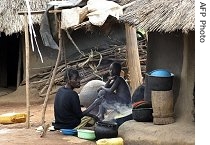2007年VOA标准英语-WFP Restores Food Rations to Displaced in Ugand(在线收听)
Geneva
12 May 2007
The World Food Program (WFP) says it will be able to restore food rations it was forced to cut for more than a million displaced people in northern Uganda. As Lisa Schlein reports for VOA from Geneva, the WFP says it is able to restore the rations because of new contributions from the international community.
 |
| A woman cooks in Unyama Camp for internally displaced people (IDP), Gulu district, northern Uganda, 02 Sep 2006 (file photo) |
WFP spokesman Simon Pluess says these cuts came at the worst time of the year.
"Just ahead of the lean season, the hunger season when people have to wait for food, for the next food harvest until August and we had to cut rations by 30 percent," he said. "And, now thanks to these new donations, we will be able to give full rations again, as of June."
The World Food Program has received nearly $7 million in new donations. Most of this has come from the European Commission's Humanitarian Aid Office. Pluess says the Commission gives its contributions in cash, not in kind.
He says this is very helpful, because it allows WFP to buy food in Uganda, which stimulates the local economy and keeps transportation costs down.
"The World Food Program procures all its food within Uganda and it has become the single largest food purchasing organization in Uganda, with some 120,000 metric tons of food purchased within the country and about 10 percent bought directly from small scale farmers," he added. "It is a very efficient way of tackling the issue of food security from another way and really help the farmers to help themselves."
The World Food Program also is feeding 183,000 refugees in Uganda and 500,000 drought victims in the Karamoja region of northeastern Uganda.